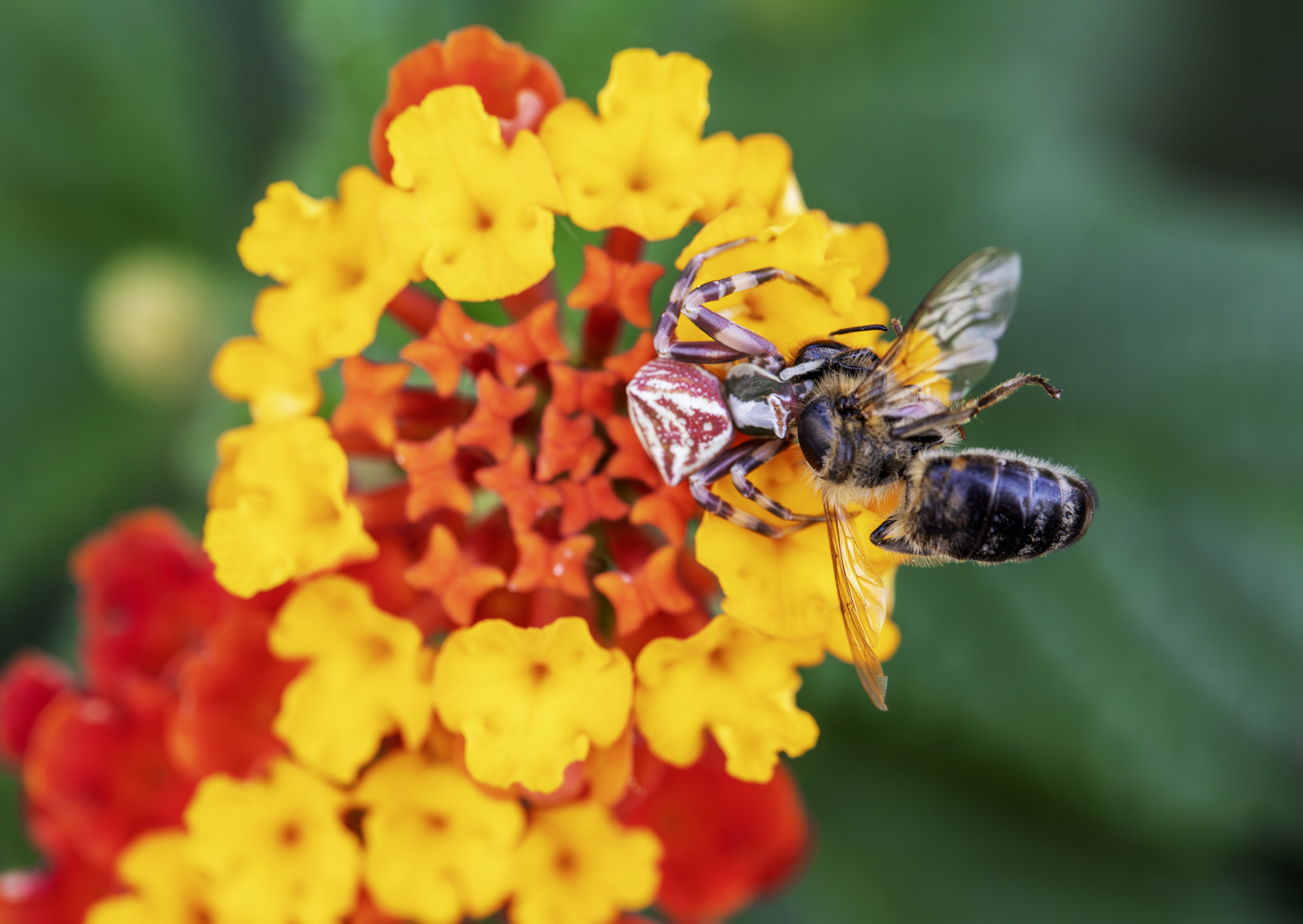The Pink Crab Spider (Thomisus onustus) is a remarkable species known for its striking appearance and fascinating behavior. Here’s an overview of this intriguing arachnid:
Description
- Appearance: The Pink Crab Spider is named for its characteristic crab-like appearance, with a wide, flat body and long, laterally extended front legs. These spiders can vary greatly in color, including shades of pink, white, yellow, and even green, depending on their environment and the flowers they inhabit.
- Sexual Dimorphism: There is notable sexual dimorphism in this species. Females are significantly larger, with a body length of up to 10 millimeters, while males are much smaller, usually around 4 millimeters in length. Males are also less colorful, often appearing brownish.
Habitat
- Distribution: Thomisus onustus is widely distributed across Europe, Asia, and parts of North Africa. They are commonly found in meadows, gardens, and other areas with abundant flowering plants.
- Preferred Environment: These spiders are typically found on flowers, where they wait for prey. Their ability to change color to match their surroundings allows them to blend in seamlessly with the petals of flowers like daisies, marigolds, and heather.
Behavior
- Hunting Strategy: The Pink Crab Spider is an ambush predator. Instead of building webs, they rely on their camouflage and patience, waiting on flowers to catch unsuspecting pollinators such as bees, butterflies, and flies. Their strong front legs allow them to quickly grasp and immobilize their prey.
- Color Change: One of the most fascinating aspects of Thomisus onustus is its ability to change color to match its surroundings. This color change can take several days and is controlled by the spider’s visual perception and hormonal signals. This adaptive camouflage helps them avoid predators and increase their hunting success.
Life Cycle
- Eggs and Spiderlings: Females lay their eggs in a silken sac attached to vegetation. They guard the eggs until they hatch, after which the spiderlings disperse. The young spiders go through several molts before reaching adulthood.
- Development: Like other spiders, Thomisus onustus undergoes incomplete metamorphosis. They grow by molting their exoskeleton multiple times before reaching full maturity.
Ecological Role
- Predator: As an ambush predator, the Pink Crab Spider plays a significant role in controlling the populations of pollinating insects. While this might seem detrimental to pollination, it also helps maintain the balance within ecosystems by keeping insect populations in check.
- Prey: These spiders are preyed upon by birds, larger insects, and other predators, making them an integral part of the food web.
Interesting Facts
- Camouflage: The ability to change color not only helps in predation but also in avoiding being preyed upon. This adaptation is relatively rare among spiders and showcases a sophisticated form of mimicry and survival strategy.
- Behavioral Adaptations: Pink Crab Spiders can adjust their hunting strategy based on the type and availability of flowers in their environment. They choose flowers that attract the most potential prey, showcasing their behavioral flexibility.
Conservation
- Threats: While not currently endangered, Pink Crab Spiders face threats from habitat loss and the use of pesticides in agriculture and gardening. Pesticides can reduce their prey availability and directly harm the spiders.
- Conservation Efforts: Promoting organic farming and gardening practices can help conserve these spiders by ensuring a healthy population of prey insects and minimizing the use of harmful chemicals.
Observing Pink Crab Spiders
- Best Time: The best time to observe these spiders is during the spring and summer months when flowers are in full bloom and insect activity is high.
- Flower Gardens: Gardens with a variety of flowering plants are excellent places to find Pink Crab Spiders. Look closely at flowers, as these spiders are masters of disguise.
The Pink Crab Spider (Thomisus onustus) is a captivating example of nature’s adaptability and the intricate relationships within ecosystems. Its unique hunting strategy, ability to change color, and role in controlling insect populations make it a fascinating subject for study and observation.
Visited 1,011 times, 7 visit(s) today
Views: 1735
Subscribe to the newsletter:
